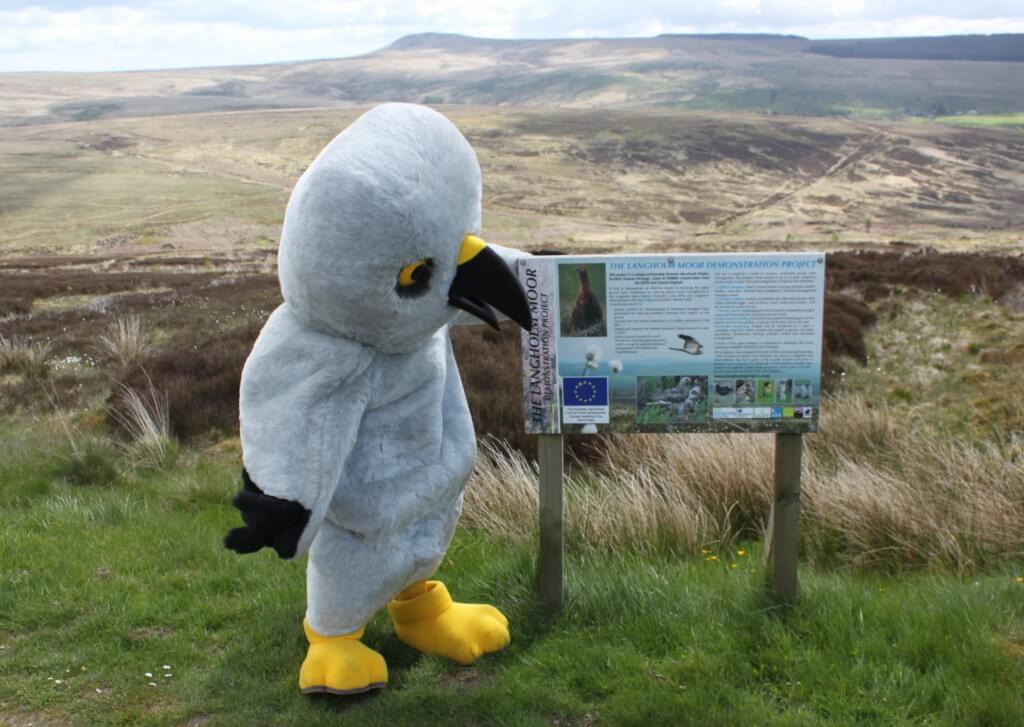Henry is here rather wistfully eyeing up the ringtail babes on this helpful sign about the second Langholm Project – Langholm 2.
Langholm 2 has been going for ages and is looking at how with better management, restoration of heather cover and techniques like diversionary feeding, Hen Harriers and driven grouse shooting might co-exist together. It’s a project that may be overtaken by events as the lack of Hen Harriers in the English uplands has worsened since the project started and then t5here were those five ‘disappearing’ male Hen Harriers this spring. Last year, the loss of Hope and Skye and the ‘we must have brood meddling even though there are hardly any broods to meddle with in England’ approach of the G(W)CT and others, will not make the great British public very sympathetic to the ‘needs’ of the shooting community.
And anyway, we are now all looking at the greenhouse gas emissions, polluted watercourses, eroded peat, damaged blanket bogs and increased flood risk and thinking that there is a bit more to this issue that the criminal killing of birds of prey. And so whether or not Langholm 2 can produce as many grouse as some shooting estates wish to see is looking less and less important in the big scheme of things. The British grouse industry has played for time on criminality and now they are caught by another threat – ecosystem disservices. It looks, in retrospect, like a bad choice by the men in tweed.
However, in another remarkable misjudgement, the G(W)CT has already written off Langholm as not going to meet its aim of producing enough Red Grouse for them to be shot out of the air by paying customers. Despite the fact that there are as many Red Grouse as there were in the last year when there was a driven grouse shoot at Langholm, and the numbers are going up, G(W)CT, last Christmas, announced the project as failing on this aim. There’s no pleasing some people, is there? The RSPB seems more optimistic on the prospects of there being grouse to be shot at Langholm than do G(W)CT – life is very strange.
[registration_form]

Why go to Langholm Moor, which is exceptionally well cared for, and raise the issue of increased greenhouse gas emissions, polluted watercourses, eroded peat, damaged blanket bogs and increased flood risk? Stand on the Moor and look around the horizon. Langholm Moor is surrounded by hundreds of square miles of inappropriate sitka spruce plantations on Kielder, Newcastleton, Eskdalemuir etc. As is well known ploughing and planting (and even worse, restocking) spruce on these fragile habitats causes the very real problems complained of but this is never mentioned.
Pete – why? Did you read the post or just shoot from the hip? Why? Because Langholm was set up to look at the relatively small issue of whether shooters and Hen Harriers can rub along together, and the issue has broadened a lot since the start of the study. That’s why.
Are you anything to do with the Langholm study by any chance?
Hi Mark,
A few points you might be able to clarify for me, I try to follow what goes on but sometimes don’t have internet access for some time, last year at one point there were 40 plus Harriers at Langholm (Adults and young) and there also was a harvestable Grouse population, who took the decision not to harvest this Grouse population, by leaving a high population of Grouse on the moors has this not led to more Harriers over wintering and therefore having higher than normal predation rates, was the decision not to shoot based on the hopes of this happening, was the decision not to shoot also based around the facts that if shooting had occurred it would be an admission of the facts that shooting and Harriers can co-exist.
The one point that Langholm 2 will make is that you can not manage a Red Grouse moor just for Red Grouse. If you only manage for heather which this scheme is doing then you can not wonder why harriers are only predating Red Grouse in winter! No management for creating suitable grassland means lack of voles when needed.